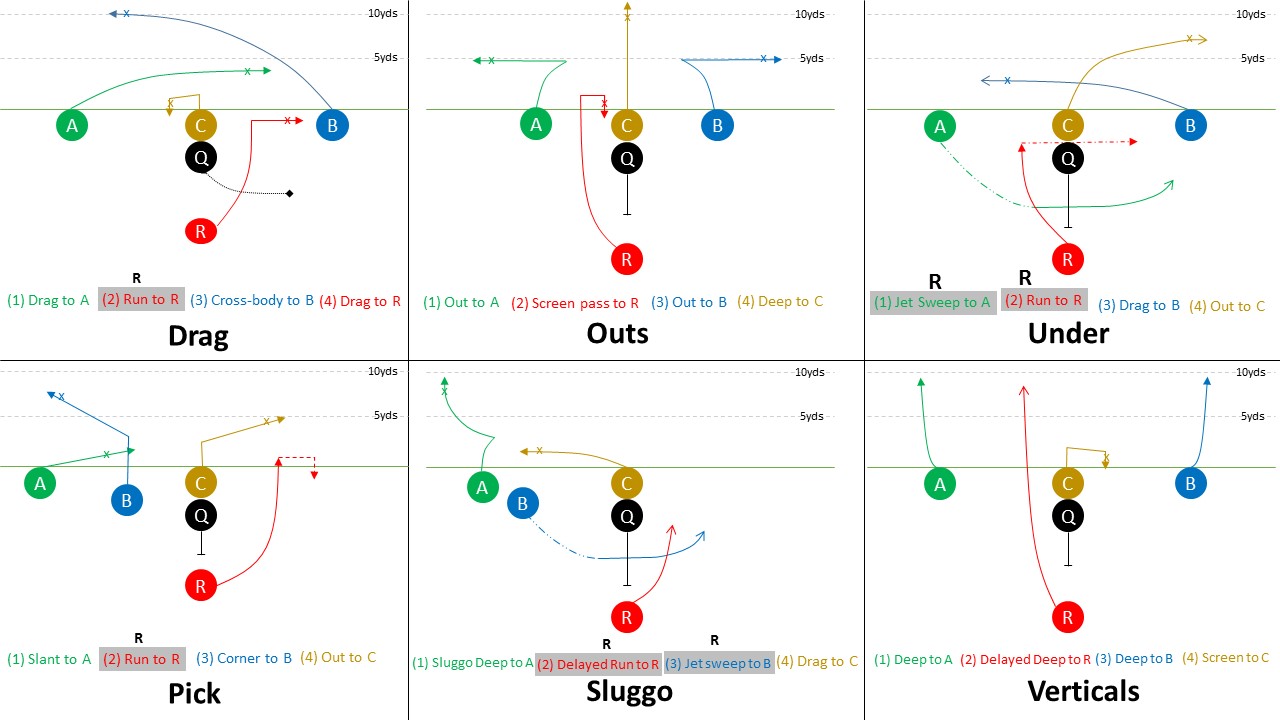Volunteer Flag Football Head Coach

Mar 2017 • teaching

From January to March 2017, I had the opportunity to coach a youth flag football team of 12-13 year old kids as part of the Cal Youth Flag Football League based out of San Jose, CA. The format of the league is 5v5 and my team had 9 total players. The teams are named after NFL teams and my team was named the Seahawks.
My job as a flag football coach is to put my players in the best position to succeed. That means striking a balance between playing to win and playing to have fun. A competitive experience is a good experience because it makes my players better. But if the experience is too competitive, frustration will push out any opportunities for learning.
Outside of running practices and calling the plays for the players during games, my job as head coach also involved communicating with parents and keeping them satisfied. I sent out weekly update emails to parents announcing the practices times and game times. I advised parents on the best type of cleats and other equipment to purchase for their players. I helped parents find the location for the game field and various practice fields.
On the field, I would always have to remember that flag football is a very different game from tackle football. Additionall, football at the 12-13 year old level is significantly different than professional football. As a coach, I need to coach for the team I have, not the professional team I dream of havinh. I need to coach for the game we're playing, not the game I wish we were playing.

What are the biggest differences in 12-13 flag football?
(1) Good flag-pulling is essential Seriously, I cannot emphasize this enough. Coaches in flag football nearly always focus on offense because it's more attractive and there's more glory to be had. Every single one of the five defenders must be a proficient flag-puller. Short passes turn into touchdowns when the defense misses on flag-pulls. I believe defense comes first - I want to trust in my defense with the game on the line.
(2) Flag football is a run-after-the-catch game, not a deep passing game. With three downs to get to midfield (30 yard distance) and three downs to score after that, every play needs to be a positive play to keep the team moving toward its goal. As a result, nearly all of the plays in our playbook need to be short passes or runs. Based on the arm strength of the 12-13 year old kids alone, passes beyond 15 yards are nearly impossible and incredibly risky.
(3) Misdirection is extremely effective. In regular football, the other team has 11 players able to stop you. In flag football, the defense has 5 players to stop the offense's 5 players. Spreading the defense out in the pros might mean you only have to get past 2 or 3 defenders to break free - if done correctly, flag football can be a one-on-one path to the end zone every single play. All the plays I design are intended to get the ballcarrier moving up field with few defenders around.

My approach toward football is pretty old school. I can summarize the above into three main points:
- Play strong defense
- Mostly short passes and runs on offense
- Don't be predictable
With those points in mind, I set about to create a playbook that best set up my team for success. And beyond just creating the playbooks, I wanted to figure out how to teach the playbook to my kids without overwhelming them. The most well-crafted playbook in the world is useless if your players can't learn it.
Drafting a playbook
These early sketches were when I began to play with formations and general layouts for playcalling. There was one thing I decided from the very start - the quarterback and center should be positioned consistently between plays. Beyond that, nearly all plays would have the quarterback taking snaps from under center. The risk of dropping a snap (instantly ends the play) goes down and the center gets a much faster route-running release when it's a short snap.



Following my third principle of misdirection and one-on-one match-ups, I drew up very few "traditional" football plays that involved passing over the middle of the field. Nearly all routes were designed to beat man-on-man coverage with horizontally breaking routes. In the rare event that the other team's defense played zone defense, I prepared a few "flood" plays meant to disrupt a zone defense. All pass plays had mostly short routes.
Another decision I made was to have every player "available" on every play. As in, there are no useless routes - every player has a chance to receive the ball on every play. That being said, there is a primary receiver and a secondary player called on every play (usually a short dump-off pass). This makes the decision really easy on the quarterback. If the main receiver is open, throw to him. If not, dump it off short with an easy pass to either the center or running back.
Since any receiver can be designated the "primary" on any given play, that means each play is actually 4 different plays. This play design makes it much simpler on the quarterback - he only needs to know the primary receiver's route on the play.

The last question was the question of formation. How many plays would I be able to run out of any given formation? The more the merrier. Different formations would give away different plays immediately. If I were to start small and build up, I would start with multiple plays out of the same formation.
There is intentionally a runningback in every single formation. This is highly unorthodox - some teams don't even have a single run play in their flag football playbook. I wanted to carry over the run-pass balance of tackle football into my flag football strategy. If there is the threat of a run play, the defense is always a little slower to react. That split second of indecision can allow receivers to get open.
For the first week, I decided to just draw up 6 good plays. In each play, four different players could be designated as the primary receiver/runner, so it was really 24 distinct plays if executed correctly. These plays are run out of just two formations. The playbook is shown below:
Seahawks 2017 CYFF Playbook

Every week, the players learn and get up to speed on three new plays. If the players can run the three plays seamlessly, we integrate the play into our routine. At practice, we will use this playbook and other drills (for flag pulling and route running) to improve on the fundamentals and prepare for the game.
Spring 2017 Season Results
| Game # | Date | W/L | Away | Home |
|---|---|---|---|---|
| 1 | Sun 2/12 | L | Seahawks 0 | Vikings 28 |
| 2 | Sun 2/19 | W | Seahawks 20 | Chiefs 6 |
| 3 | Sun 2/25 | T | Seahawks 13 | Raiders 13 |
| 4 | Sun 3/5 | W | Seahawks 39 | Saints 18 |
| 5 | Sun 3/12 | W | Seahawks 14 | 49ers 6 |
| 6 | Sun 3/12 | L | Seahawks 6 | Vikings 8 |
| WC | Sun 3/19 | W | Seahawks 20 | Raiders 6 |
| DIV | Sun 3/19 | W | Seahawks 20 | 49ers 14 |
| CHAMP | Sun 3/19 | W | Seahawks 13 | Vikings 0 |
It was a championship-winning season that began and ended with games against the same team. At one point the team was 1-1-1, but they went on to win 5 out of the next 6 to become league champions.
These were the standings at the end of the regular season:
| Seed | Team | W-L-T |
|---|---|---|
| 1 | Vikings | 5-1-0 |
| 2 | 49ers | 4-2-0 |
| 3 | Seahawks | 3-2-1 |
| 4 | Chiefs | 3-3-0 |
| 5 | Saints | 2-4-0 |
| 6 | Raiders | 0-5-1 |
Our Seahawks' 3-2-1 win/loss/tie record meant we were the #3 seed going into the playoffs. The Seahawks played three games in a row in the playoffs, defeating the #6 seed Raiders 20-6, defeating the #2 seed 49ers 20-14, and defeating the #1 seed Vikings 13-0 to win the championship game.

Thoughts from a Coach
In my first season ever as a flag football coach, our team won six games, lost two games, and tied one game. I'm very satisfied with my performance and perhaps in the future when I have more free time, I'll volunteer to coach again. It's certainly a different experience seeing football from a coach's perspective. Football is far more like chess than most people realize. You have a collection of pieces, each with different strengths and weaknesses, and as a coach, it is your job to place them in the best position to succeed.

Adding further to the complexity is the situational well-being of every player. You can't just settle on 5 "best" players and leave them in the whole game - apart from really upsetting the parents whose kids are benched, this strategy tires out your best players quickly. These kids are amateur athletes - their stamina is limited. This adds another dimension to the game of chess - it is important to cycle through your players and keep each of them fresh throughout the course of the game. As a strategist, this is also a way to gain an advantage. If I notice that a player on the opposing team is getting tired from having to run too many plays in a row, I might choose to target that weakness in the defense. I'll put in a fresh player and naturally, I'll watch as scissors beats paper.

That's plenty of a glimpse into the mind of a coach. It was a joy to be Coach Cameron to the players and I look forward to the next chance I have to get involved in football.

Harvard '19 | B.S. Electrical Engineering